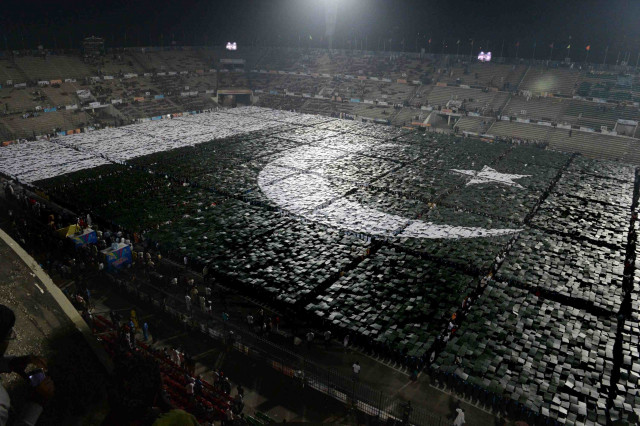Aiming high is Pakistan’s way forward
My visit to Pakistan began last week at the enormous Tarbela dam

Pakistani youths make the biggest human national flag at the National Hockey Stadium in Lahore on October 22, 2012. PHOTO:AFP
I was last in Pakistan in 2011 and I can see that big changes have happened since then.
The country has worked through three tough years that brought improvements in security and a more stable economy. Much of the economic growth has benefited poor people and Pakistan’s levels of inequality compare favourably to many middle-income countries.
Speaking to leaders in government, political parties, civil society, the private sector and various thought leaders, I sensed an optimism that the country had found its footing and is moving up the ladder of development.
This optimism is good news. But optimism needs to be supported by actions. Pakistan can move to a higher level of economic growth that reaches all parts of society, including the most marginalised, and thus fulfilling the dreams of a better life for all.
In my discussions with the government in Pakistan we focused on three areas of opportunity and challenge: the first is higher growth and jobs. The government wants annual economic growth of 6 to 7 per cent compared to 4.7 per cent achieved in fiscal year 2016. But this will only happen if investment doubles to 30 per cent of Gross Domestic Product (GDP). Investments in energy, such as Tarbela, to end constant power cuts, as well as improvements in the business environment, so that companies hire more people, will be critical to success. A more favorable environment for private investment would open up opportunities for women, youth, and the underserved.
A second area is one of the best investments Pakistan can make: investing in its own people. Pakistan’s population of 200 million is expected under current projections to double by 2050 and so these investments cannot wait. Currently Pakistan spends only three per cent of its GDP on health, nutrition, and education. This needs to double if it is to make a significant impact. Pakistan will need to raise more tax revenue to pay for these services and improve on the way that the money is spent.
A third area that I discussed with Pakistan’s leaders is the intertwined challenges of water, energy and security. Tarbela was completed in 1974 as part of the Indus Basin Project following the Indus Waters Treaty between India and Pakistan in 1960. This Treaty, to which the World Bank is a signatory, has survived frequent tensions between India and Pakistan, including conflict, and provided a framework for irrigation and hydropower development in both countries for more than half a century.
Since the Treaty was agreed, population has multiplied, use has boomed, and now we also have climate change. In the first 45 years Treaty disagreements were resolved by the Indus Waters Commission. In the past 12 years these have been elevated to a Neutral Expert and a Court of Arbitration.
What these last dozen years tell us is that South Asia needs to move beyond contesting water resources to finding a way to manage growing demands more sustainably for the benefit of all. There is a clear need for a regional integrated water resources management approach. This should incorporate water, soil and erosion, and land-use management planning to increase agricultural productivity, hydropower production, and conservation of natural resources while protecting the ecosystems of the Indus and other major rivers across South Asia.
Tackling the challenges of economic growth, human development, and energy and water issues are a top priority for Pakistan if it is to fulfill its promise. The World Bank stands ready to assist. This mission has my personal commitment and passion.
Published in The Express Tribune, January 31st, 2017.
Like Opinion & Editorial on Facebook, follow @ETOpEd on Twitter to receive all updates on all our daily pieces.













COMMENTS
Comments are moderated and generally will be posted if they are on-topic and not abusive.
For more information, please see our Comments FAQ